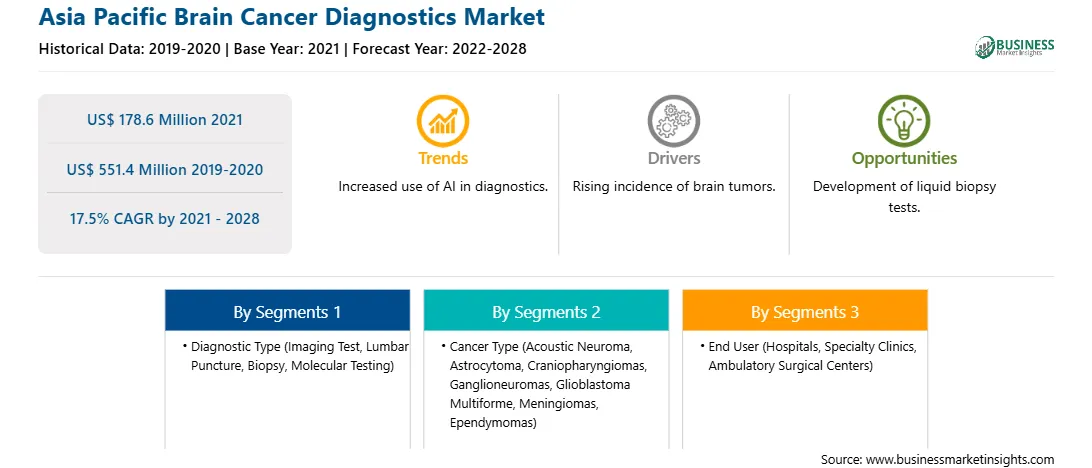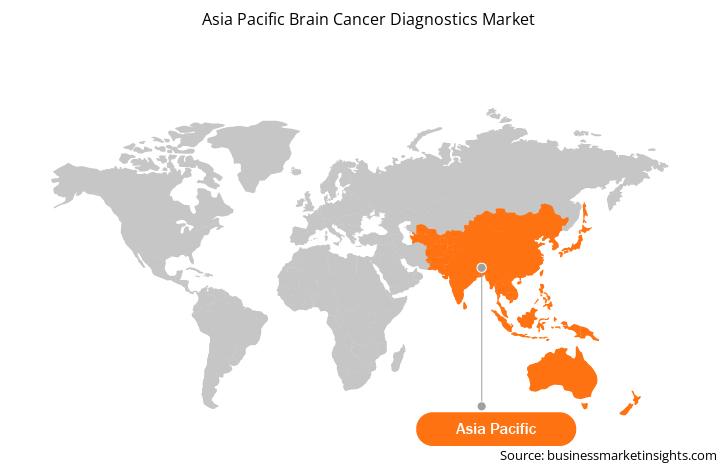Brain cancers are caused due to extracellular growth of the cells in the brain that causes tumors. The tumor includes primary brain tumors and secondary brain tumors. Primary brain tumors are formed in the brain and do not spread to other body parts, whereas secondary tumors, also known as metastases, are those cancers that began in another part of the body. Brain tumors are categorized into 40 major types that are further classified into two major groups, including benign, i.e., slow-growing and have less possibility to spread, and malignant, i.e., cancerous, and more likely to spread.
Thus, the increase in prevalence of brain cancer is expected to create a significant demand for brain cancer diagnostics in the coming years, which is further anticipated to drive the brain cancer diagnostics market.
The outbreak has severely affected the medical tourism industry in Asia pacific and imposed supply chain disruptions; moreover, low-income countries face additional challenges due to the shortage of healthcare infrastructure, restrictions imposed by hospitals to the suppliers, decreasing in demand of brain cancer diagnostics devices and others. Restrictive measures have been put forth in South Korea, Malaysia, Singapore, the Philippines, and India to prevent the disease transmission. These restrictive measures are anticipated to impact the supply chain and the availability of medical devices in these countries. It has affected disposable incomes and has also resulted in unemployment. Furthermore, business strategies such as acquisitions, mergers, and partnerships are adversely affected by the imposition of complete lockdown. Such obstructions in business activities are projected to hamper the adoption of various technologically advanced healthcare systems, including brain cancer diagnostics.

Strategic insights for the Asia Pacific Brain Cancer Diagnostics provides data-driven analysis of the industry landscape, including current trends, key players, and regional nuances. These insights offer actionable recommendations, enabling readers to differentiate themselves from competitors by identifying untapped segments or developing unique value propositions. Leveraging data analytics, these insights help industry players anticipate the market shifts, whether investors, manufacturers, or other stakeholders. A future-oriented perspective is essential, helping stakeholders anticipate market shifts and position themselves for long-term success in this dynamic region. Ultimately, effective strategic insights empower readers to make informed decisions that drive profitability and achieve their business objectives within the market.

| Report Attribute | Details |
|---|---|
| Market size in 2021 | US$ 178.6 Million |
| Market Size by 2028 | US$ 551.4 Million |
| Global CAGR (2021 - 2028) | 17.5% |
| Historical Data | 2019-2020 |
| Forecast period | 2022-2028 |
| Segments Covered |
By Diagnostic Type
|
| Regions and Countries Covered | Asia-Pacific
|
| Market leaders and key company profiles |
The geographic scope of the Asia Pacific Brain Cancer Diagnostics refers to the specific areas in which a business operates and competes. Understanding local distinctions, such as diverse consumer preferences (e.g., demand for specific plug types or battery backup durations), varying economic conditions, and regulatory environments, is crucial for tailoring strategies to specific markets. Businesses can expand their reach by identifying underserved areas or adapting their offerings to meet local demands. A clear market focus allows for more effective resource allocation, targeted marketing campaigns, and better positioning against local competitors, ultimately driving growth in those targeted areas.

The Brain cancer diagnostics market in Asia Pacific is expected to grow from US$ 178.6 million in 2021 to US$ 551.4 million by 2028; it is estimated to grow at a CAGR of 17.5% from 2021 to 2028. The term "primary brain tumor" refers to a tumor that begins in the brain. Cancer of the brain and nervous system is the tenth highest cause of mortality in men and women. In a person's lifetime, the chances of having this form of tumor are fewer than 1%. Most primary central nervous system (CNS) malignancies are brain tumors, which account for 85% to 90% of all cases. Brain tumors can be fatal, have a severe impact on quality of life, and ultimately transform a patient's and their family's lives. Furthermore, early detection of tumors often provides more treatment options. Advanced imaging technology can pinpoint the location of brain tumors. Diagnostic tools include magnetic resonance imaging (MRI) and computed tomography (CT or CAT scan). Intraoperative MRI can also be used to guide tissue biopsy and tumor resection during surgery. Magnetic resonance spectroscopy (MRS) is used to examine the chemical characteristics of tumors. Thus, the increase in the prevalence of brain cancer highly demands brain cancer diagnostic tools.
In terms of diagnostic type, the imaging test segment accounted for the largest share of the Asia Pacific brain cancer diagnostics market in 2020. In terms of cancer type, the glioblastoma multiforme segment accounted for the largest share of the Asia Pacific brain cancer diagnostics market in 2020. In terms of end user, the hospitals segment accounted for the largest share of the Asia Pacific brain cancer diagnostics market in 2020.
A few major primary and secondary sources referred to for preparing this report on the brain cancer diagnostics market in Asia Pacific are company websites, annual reports, financial reports, national government documents, and statistical database, among others. Major companies listed in the report are Thermo Fisher Scientific Inc., Siemens Healthineers A, GE Healthcare, Biocept, Inc., Koninklijke Philips N.V, Canon Medical Systems, Hitachi, Ltd., and Neusoft Medical Systems.
By Diagnostic Type
By Cancer Type
By End User
By Country
The Asia Pacific Brain Cancer Diagnostics Market is valued at US$ 178.6 Million in 2021, it is projected to reach US$ 551.4 Million by 2028.
As per our report Asia Pacific Brain Cancer Diagnostics Market, the market size is valued at US$ 178.6 Million in 2021, projecting it to reach US$ 551.4 Million by 2028. This translates to a CAGR of approximately 17.5% during the forecast period.
The Asia Pacific Brain Cancer Diagnostics Market report typically cover these key segments-
The historic period, base year, and forecast period can vary slightly depending on the specific market research report. However, for the Asia Pacific Brain Cancer Diagnostics Market report:
The Asia Pacific Brain Cancer Diagnostics Market is populated by several key players, each contributing to its growth and innovation. Some of the major players include:
The Asia Pacific Brain Cancer Diagnostics Market report is valuable for diverse stakeholders, including:
Essentially, anyone involved in or considering involvement in the Asia Pacific Brain Cancer Diagnostics Market value chain can benefit from the information contained in a comprehensive market report.